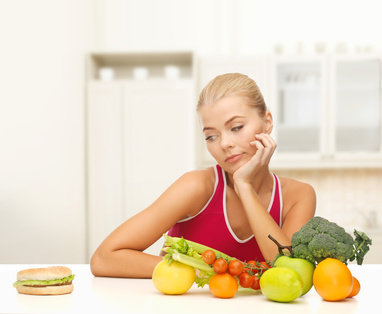 Why is grocery shopping on an empty stomach such a bad idea? More likely than not some items appear in your cart that were not on the grocery list. Not to mention, your wallet might be a bit thinner than anticipated after the shop. This is an example of “hot state” decision making. The decisions are impulsive, led by the empty feeling in your belly rather than by the rational boundaries of your health goals and budget. Stress and distraction can lead to impulsive choices and it takes active effort and resources to resist. In a hot state consumers tend to eat for taste, convenience, size (bigger is better), and appearance often telling themselves that their decision is an exception. In a buying situation, consumers in a “hot state” tend to buy larger portions or packages, make more financially indulgent choices and often buy more calorie dense “comfort food.”
Why is grocery shopping on an empty stomach such a bad idea? More likely than not some items appear in your cart that were not on the grocery list. Not to mention, your wallet might be a bit thinner than anticipated after the shop. This is an example of “hot state” decision making. The decisions are impulsive, led by the empty feeling in your belly rather than by the rational boundaries of your health goals and budget. Stress and distraction can lead to impulsive choices and it takes active effort and resources to resist. In a hot state consumers tend to eat for taste, convenience, size (bigger is better), and appearance often telling themselves that their decision is an exception. In a buying situation, consumers in a “hot state” tend to buy larger portions or packages, make more financially indulgent choices and often buy more calorie dense “comfort food.”
Instead of allowing your stomach to get the best of you and your wallet, be sure to have a clear mind and full belly next time you anticipate making food related decisions. The ideal state to be in when making food choices is a “cold state.” In a “cold state,” decisions tend to be more rational and consumers tend to consider price, health information, and long term benefits when making food decisions. Without stress factors like hunger and time constraints, people tend to make more nutritionally conscious decisions.
How does this apply to children in the lunch line? According to Dr. David Just co-director of Cornell University’s Center for Behavioral Economics in Child Nutrition Programs (BEN Center), often children will be in a “hot state” when they are at lunch because they may be stressed by their school work or an upcoming presentation. They might feel hurried to get though the line in order to have enough time to enjoy socializing. Similar to being hungry in the grocery store, students in the lunch line tend to be impulsive and, therefore, will chose what is quick and easy. Generally, it is the prepackaged foods like chips and cookies that are the easiest to grab and go. However, healthier foods, like cut fruit and vegetables can be packaged as quick and easy snacks too!
Contributors
Katherine Baildon Cornell University Center for Behavioral Economics in Child Nutrition Programs
Source
“Introduction to Behavioral Economics Powerpoint” Cornell Center for Behavioral Economics in Child Nutrition Programs’ Smarter Lunchrooms Movement
